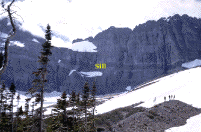
Volcano World was one of the first geoscience resources on the Internet. For this exercise you will need a map showing theplate boundaries [if you print from the browser, turn the image on its side and reduce the size to about 75% for the best effect), or you can copy the larger figure on the inside cover of the text.
This exercise will take about a month the way it is designed. Your instructor may elect to modify the exercise to better fit the class schedule.
Look at the Update on Current Volcanic Activity. Prepare a table in which you list the 10 most recent volcanic events prior to March 1, 2001:
| Location | Composition | Explosivity Index | Remarks |
|---|
Under the Remarks column tell whether the volcano is located at a plate boundary or within a plate. If the volcano occurs at a plate boundary tell what kind of boundary.
Locate each of these events with a red circle on your reference map.
Questions
In general, the viscosity of a melt (a measure of its resistence to flow) is inversely proportional to its temperature. At high temperatures the melt tends to flow more readily than at low temperatures. Water can drastically modify the viscosity of a melt; the higher the water content, the lower the viscosity.
Field trips are the geologists counterpart of a case history. Virtual Field trips are not a substitute for being in the field in person. However, it rarely rains on a virtual field trip and I am not aware of a student suffering a snakebite.
Take some time and Virtually Climb Stromboli. Answer the following questions upon your safe return:
Something Extra